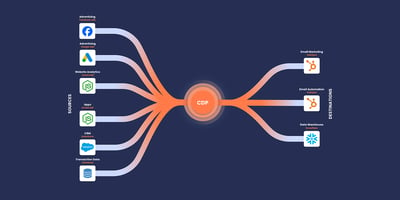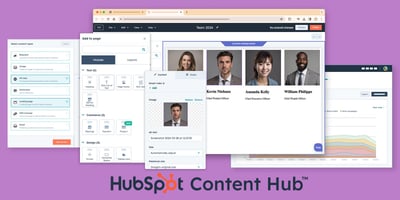The reality is that measurement and tracking is the cornerstone of achieving targets and goals in life and sales targets are no different. In the video below I cover how we used HubSpot Sales Professional and HubSpot CRM to supercharge our sales process and grow our agency revenue by 35% in Q1 of our financial year.
Video Transcript:
How can using a CRM increase your sales performance?
Well, our agency over the last financial quarter has improved its results by 35% over our average quarterly turnover last year and I can attribute it a hundred percent to CRM and a really good sales enablement program.
So that wasn't always the case that CRM was this really successful thing for me. About seven or eight years ago I was working in telecoms and we had to use salesforce.com to track everything.
We were mandated by management to track all your communication, to track all your deals but actually all we tracked was deals because tracking everything else in the communication from meetings to discussions of clients was just absolutely impossible. Our direct line managers or sales managers realized this and then knew that it would take time off our selling - so all they wanted us to do was deal management. The reality is, things have changed and CRM has become much more automatic and tracking all of this stuff is so much easier. So let me go through a few of the ways that CRM has changed and motivate why you should be using a CRM in your sales process. And I mean a lot of this comes from our own usage of CRM and its success...
We've got a number of clients that we use CRM with and we do a lot of sales enablement programs, so these are the sort of core features of CMS and sales enablement that really make a difference to the bottom line of a sales department.
Email integration with CRM
The first is email integration, both Gmail and Outlook integrate perfectly into most modern day CRMs. Send an email to a prospect - it's tracked. Send a meeting request to a prospect - it's tracked. You no longer have to go manually track your tasks in a CRM. Integrated into this automation is real-time notification. So if you send an email to a client - when they open it - you're notified. You're notified either to your email inbox or an app on your phone. I prefer a notification to my phone on my app - we all get far too much email.
CRMs save time and boost productivity
The next thing that really kind of enhances productivity of a sales team are templates and documents. Most modern CRMs have a battery of templates and documents that are easily on hand inside the email client for salespeople to share with their prospects. For example, our marketing team creates templates on a monthly basis for our sales team to use. These include canned messages with product information and industry related information. The salesperson literally just selects them in the email clients it pulls through all the copy links and attachments.
It actually even personalizes the email so they can just click send. We advocate modifying them a little bit so they're customized but with this kind of method a salesperson can send 50 nurturing emails in an hour. This could never be done before when everything was entirely manual. In addition to the templates, we've got documents and what our marketing team does is they curate a selection of documents. These documents include pricing product specs and solutions case studies. They're all up to date so the salesperson can easily go into the email clients, select documents and pull those documents into the email. There's no need for the salesperson to maintain their own collection of documents, some of which are often out-of-date. They're always up to date, they're always relevant. We started talking a little bit about marketing so let's talk a bit about the website...
CRM Integrated Websites
The website is where a lot of leads come into the business. Sales need to close those leads, but the way those leads are delivered to the sales team is through automation - we call this lead rotation. They're literally doled out one by one and marketing can then see the progress of those leads as the salespeople nurture them through the various deal stages.
What we can also do is score those leads depending on what they do. For example, they come back to the website, or look at a pricing page, open a quote, or download some information off the website. All of those factors go into the prospects lead score and what a salesperson can now do is sort all their prospects by a lead score. The higher the score, the higher the likelihood the lead is going to close and now what we starting to talk about is marketing automation.
Marketing Automation
Now, a lot of these functions that I've been talking about have been pulled by the CRM companies from marketing automation companies. In fact salesforce.com bought a marketing automation company to to enhance their CRM. We use a CRM called HubSpot, which was actually originally a marketing automation company and slowly but surely built very powerful sales and CRM functions. Marketing automation has mostly been run by the marketing departments, CRM traditionally part the sales departments. Those roles are really merging now and there's a term called smarketing, which is a mishmash of the two words, and what that entails is basically deciding on SLA's between the sales and marketing departments (what marketing is responsible for and what sales is responsible for). So often, the sales department will say, 'the leads from the marketing department are terrible' and marketing will say, 'the sales department aren't closing the leads properly
It's very important to make sure that both teams understand what's happening and the integration of marketing automation and CRM's is really helping both teams to see or have line of sight of both of these elements.
One of the really cool things that our marketing team does for our sales team is nurturing emailers. So every month they come up with a set of emails and they send them out on behalf of the salespeople. They're almost like monthly mailers or newsletters, let's call them that - except they actually come from the salesperson and they're personalized to the prospect. Those are sent automatically and those are great for prospects that might have fallen off the salespersons radar. They're automatically nurtured every month and when they actually click on a link and come back to the website again, automatically the salesperson is notified to therefore email that this prospect or take some other form of action.
CRM for management and reporting
So let's talk about management and reporting. Obviously deal tracking is a cornerstone of any sales CRM, but of course - meetings attract calls, attract emails, attract contacts worked per month, per week, per day, meeting to close ratios call to close ratios. The data could be sliced in a multiplicity of ways.
Of course we've got the app - any sales manager will check in on the app every single day see what deals have been added, what's being closed, what's late, the management functions, especially for managers - are really really tight these days so to wrap it up,
Summary on Modern CRM
CRM has come a hell of a long way. Don't be nervous about a CRM and think it's gonna take your salespeople, or if you are a salesperson, that it's gonna take you hours and hours to add all this information and actually get any value out of it. A lot of it is automated these days, give it a try
- my belief is: if you're not using a CRM and a sales tool in your sales process today - you're really selling yourself short.
If you're interested in chatting about CRM, HubSpot, sales automation, or sales enablement - give us a shout. We do it for a lot of companies and we'd love to chat to you about it.
If you loved this content and want a hardcopy or more detail, download our eBook on the subject.





